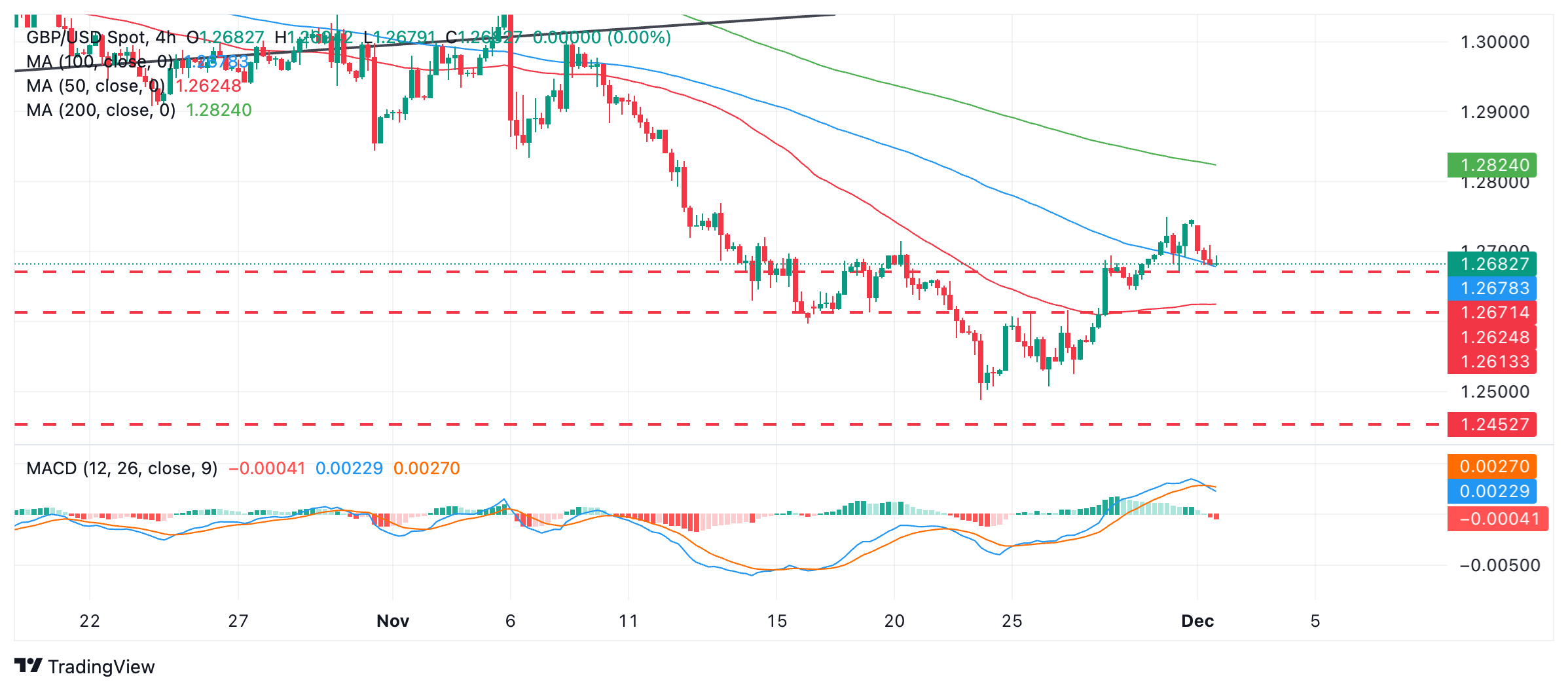- The Pound Sterling falls against the US Dollar on Monday after Donald Trump threatened the BRICS with 100% tariffs, supporting the Dollar.
- Trump said he would impose tariffs if the trade group tried to replace the US dollar with its own reserve currency.
- Technically, GBP/USD is still in an uptrend, within which it is experiencing a correction.
The British Pound (GBP) retreats below the 1.2700 mark on Monday after more invective from President-elect Donald Trump strengthened the US Dollar (USD).
In a social media post, Trump lashed out at the BRICS trading bloc’s plans to replace the US dollar with its own currency. If the emerging markets trading bloc moves forward, Trump warned, he would impose 100% tariffs on them.
The GBP/USD pair rebounds briefly, however, following the release of UK house price data that showed house prices rose more than expected in November, providing support to the British pound. .
British Pound Falls After Trump Lashes Out at BRICS
The GBP/USD pair is trading lower on Monday after rising quite strongly the previous week, when it posted gains of 1.71%.
The pair is falling after Donald Trump threatened to impose 100% tariffs on the BRICS trading bloc of nations, which includes Brazil, Russia, India, China, South Africa, Egypt, Iran, the United Arab Emirates and Ethiopia. Trump said he would impose the tariffs if the group goes ahead with plans to replace the US dollar as its main medium of exchange.
“The idea that the BRICS countries are trying to get away from the Dollar while we stand by and watch is OVER,” Trump posted on Truth Social on Saturday afternoon. “We require a commitment from these countries that they will not create a new BRICS currency, support any other currency to replace the powerful US dollar, or face 100% tariffs, and should expect to say goodbye to selling into the wonderful US economy,” he added. .
Sterling gets a boost from UK house prices
GBP/USD regained some lost ground after Nationwide’s house price release early on Monday showed a 3.7% year-on-year increase in November, beating estimates of 2.4% and rising year-on-year of 2.4% from the previous month.
On a seasonally adjusted monthly basis, Nationwide house prices rose 1.2% – well above the 0.2% expected and the previous estimate of 0.1%.
UK money and lending data released on Friday, meanwhile, showed a drop in consumer credit in October. However, mortgage approvals rose unexpectedly.
The overall conclusion, according to economists at advisory service Capital Economics, was that the data suggested “downside risks” to UK economic growth in the fourth quarter.
“October’s money and borrowing figures suggest that budget concerns led households to be more cautious with their borrowing and savings,” Capital said in a note. “Today’s data release adds a bit more downside risk to our fourth quarter GDP growth forecast of +0.4% quarter-on-quarter,” he added.
GBP/USD and outlook for interest rates
In terms of the outlook for interest rates – an important factor in currency valuations – the British pound and the US dollar are well matched.
Both the Bank of England (BoE) and the US Federal Reserve (Fed) are expected to cut interest rates at their December policy meetings as inflation in both countries declines.
The swaps market is pricing in a around 60% chance that the BoE will cut interest rates by 0.25% at its December meeting, according to Brown Brothers Harriman (BBH). Meanwhile, the US futures market is pricing in a around 67% chance of a cut of the same size at its December meeting, according to the CME FedWatch tool.
This could limit GBP/USD volatility as lower interest rates would be bearish for both currencies as they reduce foreign capital inflows.
Technical Analysis: GBP/USD retreats within the uptrend
GBP/USD retreats below the 1.2700 level and finds support at the 1.2660 area. The pair remains within a short-term uptrend, which remains intact despite Monday’s losses. Since it is a principle of technical analysis that “the trend is your friend”, the odds continue to favor an extension of this upward trend.
GBP/USD 4-hour chart
A break above 1.2750 would likely trigger the next upside target around 1.2824, where the 200 SMA sits (green).
A continuation lower, however, could take the pair to support at 1.2671, the mid-November lows.
The blue Moving Average Convergence/Divergence (MACD) indicator has crossed below its red signal line, suggesting more weakness to come.
The medium-term trend remains bearish, indicating a downside risk, while the long-term trend – one could argue – remains likely bullish, further complicating the picture.
The British Pound FAQs
The British Pound (GBP) is the oldest currency in the world (AD 886) and the official currency of the United Kingdom. It is the fourth most traded foreign exchange (FX) unit in the world, accounting for 12% of all transactions, averaging $630 billion a day, according to 2022 data. Its key trading pairs are GBP/ USD, which represents 11% of FX, GBP/JPY (3%) and EUR/GBP (2%). The British Pound is issued by the Bank of England (BoE).
The most important factor influencing the value of the Pound Sterling is the monetary policy decided by the Bank of England. The Bank of England bases its decisions on whether it has achieved its main objective of “price stability” – a constant inflation rate of around 2%. Its main tool to achieve this is the adjustment of interest rates. When inflation is too high, the Bank of England will try to control it by raising interest rates, making it more expensive for people and businesses to access credit. This is generally positive for sterling, as higher interest rates make the UK a more attractive place for global investors to invest their money. When inflation falls too much it is a sign that economic growth is slowing. In this scenario, the Bank of England will consider lowering interest rates to make credit cheaper, so that companies will take on more debt to invest in projects that generate growth.
The data released measures the health of the economy and may affect the value of the pound. Indicators such as GDP, manufacturing and services PMIs and employment can influence the direction of the Pound.
Another important piece of information that is published and affects the British Pound is the trade balance. This indicator measures the difference between what a country earns from its exports and what it spends on imports during a given period. If a country produces highly in-demand export products, its currency will benefit exclusively from the additional demand created by foreign buyers seeking to purchase those goods. Therefore, a positive net trade balance strengthens a currency and vice versa in the case of a negative balance.
Source: Fx Street
I am Joshua Winder, a senior-level journalist and editor at World Stock Market. I specialize in covering news related to the stock market and economic trends. With more than 8 years of experience in this field, I have become an expert in financial reporting.








